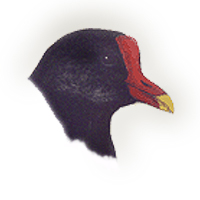|
Field
Guide IDs: BREEDING:
Freshwater marshes,
lakes, and ponds, usu with emergent veg and grassy
edges. Occ 2, rarely 3, broods. DISPLAYS:
With head low,
wings partly raised and open, elevates tail
exposing white undertail feathers. Male bends head
down and in toward feet; male and female
bow. NEST:
Usu over water
(with ramps leading down to water), occ on ground
or in low shrub. Occ with canopy. Well-rimmed cup
of conspicuous bleached aquatic plants, lined with
grass. Unused nests, brooding and roosting
platforms nearby. Occ use old nest of jays,
magpies. EGGS:
Cinnamon/buff,
marked with reddish-brown or olive. 1.7" (44
mm). DIET:
Mostly aquatic veg;
also mollusks (esp snails), worms; berries,
fruit. CONSERVATION:
Winters s to c
S.A. NOTES:
Cooperative breeder
with young of first brood often aiding in care of
subsequent broods and in defense of territory.
Brood parasitism: clutches >13 likely result
from >1 female laying in nest. Younger birds lay
smaller clutches than older birds and lay later.
Young usu hatch asynchronously. Wing spur aids
young in climbing. ESSAYS: Cooperative
Breeding;
Thin
as a Rail;
Variation
in Clutch Sizes;
Brood
Parasitism;
American
Coots. REFERENCES:
Cramp and Simmons,
1980; Petrie, 1986. |
